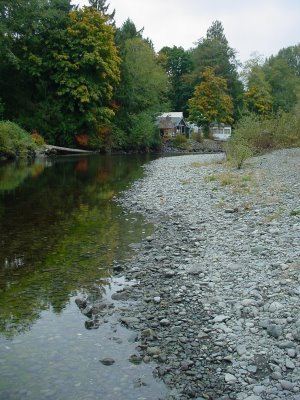 We packed up the canoe and headed out for a paddle on the Duckabush River Delta on the Hood Canal. Fog nestled in the trees and along the mountains and meadows along the way.
We packed up the canoe and headed out for a paddle on the Duckabush River Delta on the Hood Canal. Fog nestled in the trees and along the mountains and meadows along the way. It is about a two hour drive to Hoodsport and the Duckabush River, much of it through farmlands, forests and the quaint community along the Hood Canal. This old barn was along a country road, not far from the delta.
It is about a two hour drive to Hoodsport and the Duckabush River, much of it through farmlands, forests and the quaint community along the Hood Canal. This old barn was along a country road, not far from the delta.The Duckabush River Delta is a critical wetland area managed by the Department of Fish and Wildlife. It is a prime habitat for seals (we saw at least 40), trumpeter swans, and critical fish stocks. As we paddled up the river, we noticed many schools of young salmon, and also the old salmon dying along the riverbottom.
 We had to wait for the tides to be just right before we could head upriver, otherwise the low tide makes paddling impossible. George has been wanting to do this paddle for years, but had to wait for the right tides and weather to do it. It is a beautiful, clear river, with little cabins nestled along the edges.
We had to wait for the tides to be just right before we could head upriver, otherwise the low tide makes paddling impossible. George has been wanting to do this paddle for years, but had to wait for the right tides and weather to do it. It is a beautiful, clear river, with little cabins nestled along the edges. The water was a deep emerald green, and the riverbank was still verdant with ferns, wild roses, and currant. Cars were lined up along the highway, with throngs of fishermen. Access Washington's News Releases at this time last year reported: "Chum are already abundant near the Hoodsport hatchery on Hood Canal, said Mark Cylwick, WDFW hatchery specialist. They began showing up the third week of October. The chum normally peaks just before Thanksgiving. "They're running a little bit early right now, so that indicates we're going to have a giant run or that things might peter out a little early," Cylwick said. He described the chum as semi-dark with some brights mixed in. "Usually the fish are in pretty good shape out here in front of the hatchery because they're still in saltwater." he said. A creel check Oct. 29 on the Hoodsport shore showed 59 anglers with 42 chum. . ."
The water was a deep emerald green, and the riverbank was still verdant with ferns, wild roses, and currant. Cars were lined up along the highway, with throngs of fishermen. Access Washington's News Releases at this time last year reported: "Chum are already abundant near the Hoodsport hatchery on Hood Canal, said Mark Cylwick, WDFW hatchery specialist. They began showing up the third week of October. The chum normally peaks just before Thanksgiving. "They're running a little bit early right now, so that indicates we're going to have a giant run or that things might peter out a little early," Cylwick said. He described the chum as semi-dark with some brights mixed in. "Usually the fish are in pretty good shape out here in front of the hatchery because they're still in saltwater." he said. A creel check Oct. 29 on the Hoodsport shore showed 59 anglers with 42 chum. . .""This time of year, anglers have to play the weather as well as the fish, Thiesfeld said. They need to hit the rivers when they're high enough to bring in salmon, but not so high that they're unfishable. "This is a typical fall pattern," Thiesfeld said. "You watch the weather and stream gauges. If the rivers drop back into shape, you go. If not, you stay home and watch football or go blackmouth fishing."
 This was our 'put in place'. We slid the canoe down the embankment along the left, then paddled for about an hour and a half up-river, then down-river out to the delta. There, we watched seals bobbing in the water. I was able to videotape the vast imagery of the delta, with the fog distant in the trees and the seals barking at us.
This was our 'put in place'. We slid the canoe down the embankment along the left, then paddled for about an hour and a half up-river, then down-river out to the delta. There, we watched seals bobbing in the water. I was able to videotape the vast imagery of the delta, with the fog distant in the trees and the seals barking at us.We pulled the canoe up onto a grassy bank and found a wild apple tree, just covered in perfect red apples. I emptied my camera box and we shook some of the apples down. We filled the box, and I plan to make a couple of apple pies, and some applesauce.